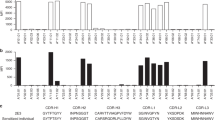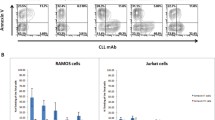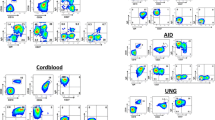Abstract
To study the gene products of theHLA complex, we produced two monoclonal antibodies, termed HU-18 and HU-23. They were active in complement-dependent cytotoxicity and detected B-cell alloantigens encoded by a locus (or loci) linked toHLA. When three types of HLA-DR4 homozygous B-cell lines with different HLA-D specificities were tested for reactivity with HU-18 and HU-23, they displayed distinct reaction patterns depending on the HLA-D specificities they possessed: EBV-Wa (HLA-DYT homozygous), negative for both HU-18 and HU-23; KT2 and KOB (HLA-DKT2 homozygous), positive only for HU-18; and ER (HLA-Dw4 homozygous), positive for both. These differential reaction patterns were further confirmed by testing against a panel of 17 HLA-DR4-positive peripheral blood lymphocytes with known HLA-D specificities. Thus, these monoclonal antibodies allow us to identify HLA-DYT, HLA-DKT2, and HLA-Dw4 solely by serologic methods. This is the first clearcut serologic identification of these three HLA-DR4-associated HLA-D specificities, which have been indistinguishable by conventional serology and identified only by cellular techniques. It is hoped that immunochemical investigations using HU-18 and HU-23 will advance our understanding of theHLA-D region on a molecular level.
Similar content being viewed by others
References
Brodsky, F. M., Parham, P., and Bodmer, W. F.: Monoclonal antibodies to HLA-DRw determinants.Tissue Antigens 16: 30–48, 1980
Corte, G., Calabi, F., Damiani, G., Bargellesi, A., Tosi, R., and Sorrentino, R.: Human la molecules carrying DC1 determinants differ in both a- andβ-subunits from la molecules carrying DR determinants.Nature 292: 357–360, 1981
Cresswell, P. and Geier, S. S.: Antisera to human B-lymphocyte membrane glycoproteins block stimulation in mixed lymphocyte culture.Nature 257: 147–149, 1975
Danilovs, J. A., Ayoub, G., and Terasaki, P. I.: B lymphocyte isolation by thrombin-nylon wool.In P.I. Terasaki (ed.):Histocompatibility Testing 1980, pp. 287–288, UCLA Tissue Typing Laboratory, Los Angeles, 1980
Dupont, B., Braun, D. W., Yunis, E. J., and Carpenter, C. B.: Joint report. HLA-D by cellular typing.In P. I. Terasaki (ed.):Histocompatibility Testing 1980, pp. 229–267, UCLA Tissue Typing Laboratory, Los Angeles, 1980
Greenwood, F. C., Hunter, W. M., and Glover, J. S.: The preparation of131I-labelled human growth hormone of high specific radioactivity.Biochem. J. 89: 114–123, 1963
Kaneko, T., Ishigamori, E., Otani, F., Watanabe, K., and Kashiwagi, N.: Characteristics of DYT and DKT2 specificities.In P. I. Terasaki (ed.):Histocompatibility Testing 1980, pp. 891–892, UCLA Tissue Typing Laboratory, Los Angeles, 1980
Kasahara, M., Ogasawara, K., Ikeda, H., Okuyama, T., Ishikawa, N., Takenouchi, T., Wakisaka, A., Kikuchi, Y., and Aizawa, M.: A monoclonal antibody that detects a polymorphic determinant, common to HLA-DRI and 2.Tissue Antigens, in press, 1983
Katagiri, M., Ikeda, H., Maruyama, N., Moriuchi, J., Wakisaka, A., Kimura, S., Aizawa, M., and Itakura, K.: Evidence for two B-cell alloantigen loci in theHLA-D region.Immunogenetics 9: 335–351, 1979
Kearney, J. F., Radbruch, A., Liesegang, B., and Rajewsky, K.: A new mouse myeloma cell line that has lost immunoglobulin expression but permits the construction of antibody-secreting hybrid cell lines.J. Immunol. 123: 1548–1550, 1979
Köhler, G. and Milstein, C.: Continuous cultures of fused cells secreting antibody of predefined specificity.Nature 256: 495–497, 1975
Koide, Y., Awashima, F., Yoshida, T. O., Takenouchi, T., Wakisaka, A., Moriuchi, J., and Aizawa, M.: The role of three distinct la-like antigen molecules in human T cell proliferative responses: effect of monoclonal anti-la-like antibodies.J. Immunol. 129: 1061–1069, 1982
Morton, N. E.: Further scoring types in sequential linkage tests, with a critical review of autosomal and partial sex linkage in man.Am. J. Hum. Genet. 9: 55–75, 1957
Nakai, Y., Kasahara, M., Moriuchi, J., Masuda, K., Wakisaka, A., Aizawa, M., and Itakura, K.: The heterogeneity of antigen DRw8.Transplant. Proc. 13: 1996–1999, 1981
Oi, V. T. and Herzenberg, L. A.: Immunoglobulin-producing hybrid cell lines.In B. B. Mishell and S. M. Shiigi (eds.):Selected Methods in Cellular Immunology, pp. 351–372, W. H. Freeman and Company, San Francisco, 1980
Sasazuki, T., Kohno, Y., Iwamoto, I., Tanimura, M., Naito, S., Kashiwagi, N., Itakura, K., Aizawa, M., Hasegawa, T., Miyajima, T., Akiyama, N., Juji, T., Tsuji, K., Sekiguchi, S., Yoshida, T. O., Akaza, T., Matsuyama, M., and Toyoda, K.: Japanese regional report. The relationship between HLA-D and WIA specificities in the Japanese population.In W. F. Bodmer, J. R. Batchelor, J. G. Bodmer, H. Festenstein, and P.J. Morris (eds.):Histocompatibility Testing 1977, pp. 489–498, Munksgaard, Copenhagen, 1978
Sasazuki, T., Ohta, N., Isohisa, I., Numano, F., and Maezawa, H.: Association between Takayasu disease and HLA-DHO.Tissue Antigens 14: 177–178, 1979
Sasazuki, T., Kaneoka, H., Tsuji, K., Nose, Y., Kashiwagi, N., and Kaneko, T.: Joint report. HLA-D in Japan.In P.I. Terasaki (ed.):Histocompatibility Testing 1980, pp. 274–276, UCLA Tissue Typing Laboratory, Los Angeles, 1980
Sekiguchi, S., Kreisler, M., Omori, K., Nakata, S., Park, M. S., and Jeannet, M.: Joint report. 8WDRW6Y (6.3, Se6).In P.I. Terasaki (ed.):Histocompatibility Testing 1980, pp. 530–531, UCLA Tissue Typing Laboratory, Los Angeles, 1980
Shackelford, D. A., Mann, D. L., van Rood, J. J., Ferrara, G. B., and Strominger, J. L.: Human B-cell alloantigens DC1, MT1, and LB12 are identical to each other but distinct from the HLA-DR antigen.Proc. Nod. Acad. Sci. U.S.A. 78: 4566–4570, 1981
Simons, M.J.: Joint report.In M.J. Simons (ed.):Proceeding of the Second Asia-Oceania Histocompatibility Workshop Conference, Melbourne, in press, 1983
Takenouchi, T., Kasahara, M., Ogasawara, K., Ikeda, H., Ishikawa, N., Okuyama, T., Wakisaka, A., and Aizawa, M.: Monoclonal antibody HU-18 detects TB21 specificity.In M. J. Simons (ed.):Proceeding of the Second Asia-Oceania Histocompatibility Workshop Conference, Melbourne, in press, 1983
Tanigaki, N., Tosi, R., Pressman, D., and Ferrara, G. B.: Molecular identification of human la antigens coded for by a gene locus closely linked to HLA-DR locus.Immunogenetics 10: 151–167, 1980
Tosi, R., Tanigaki, N., Centis, D., Ferrara, G. B., and Pressman, D.: Immunological dissection of human la molecules.J. Exp. Med. 148: 1592–1611, 1978
Williams, A. F.: Differentiation antigens of the lymphocyte cell surface.In R. R. Porter and G. L. Ada (eds.):Contemporary Topics in Molecular immunology 6, pp. 83–116, Prenum Press, New York, 1977
Yakura, H., Wakisaka, A., Aizawa, M., Itakura, K., Tagawa, Y., and Sugiura, S.: HLA-D antigen of Japanese origin (LD-Wa) and its association with Vogt-Koyanagi-Harada syndrome.Tissue Antigens 8: 35–42, 1976
Author information
Authors and Affiliations
Rights and permissions
About this article
Cite this article
Kasahara, M., Takenouchi, T., Ogasawara, K. et al. Serologic dissection of HLA-D specificities by the use of monoclonal antibodies. Immunogenetics 17, 485–495 (1983). https://doi.org/10.1007/BF00696872
Received:
Issue Date:
DOI: https://doi.org/10.1007/BF00696872




